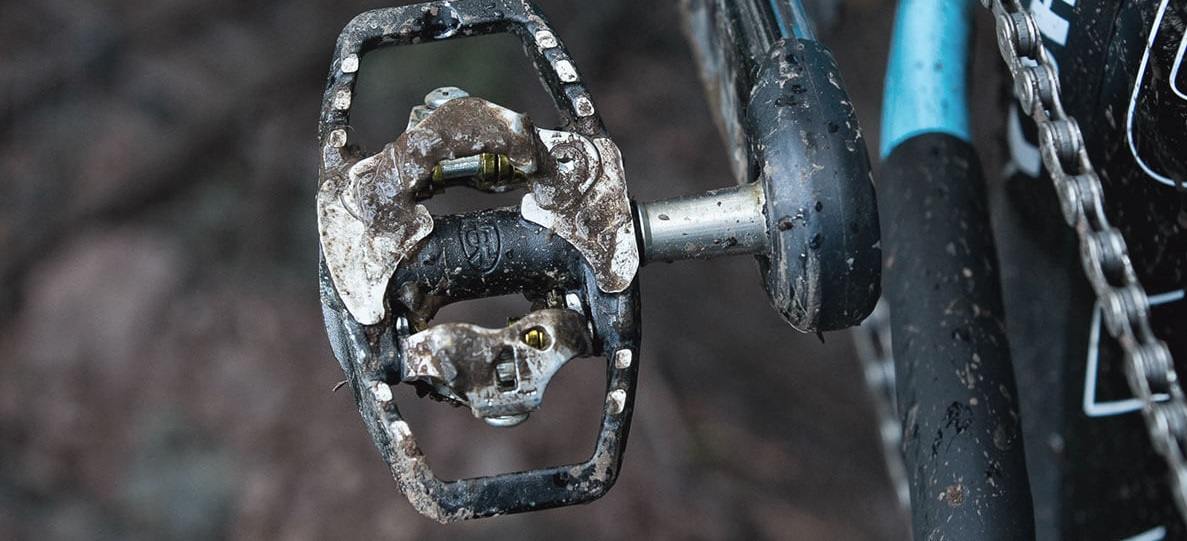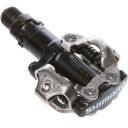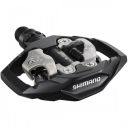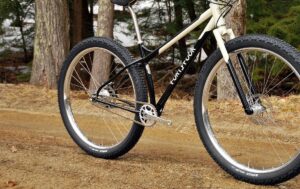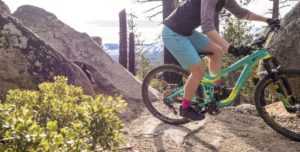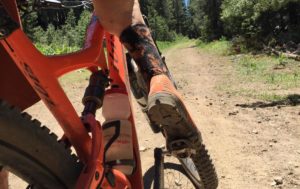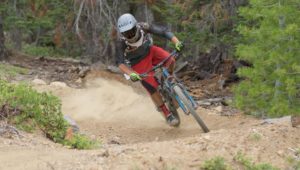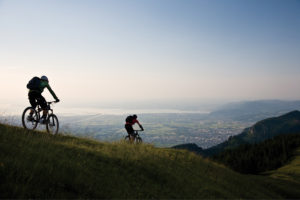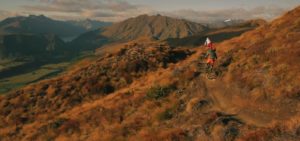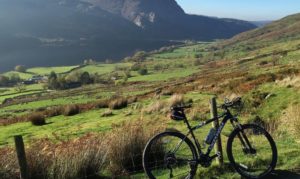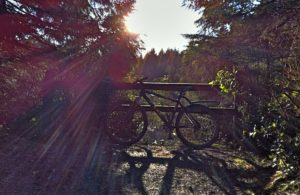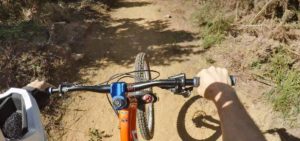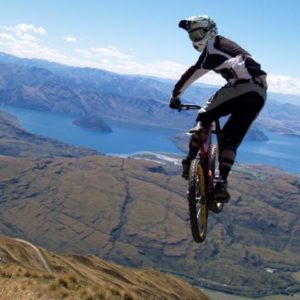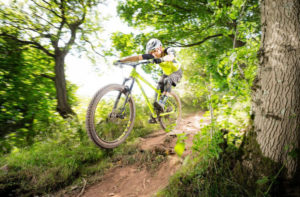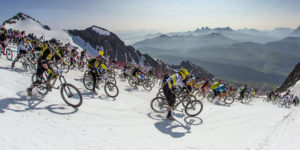What is the best clipless pedal for your mountain bike? We evaluated eight pairs of mountain bike pedals on a whole fleet of bikes to find that answer. We had multiple riders with differing abilities and riding styles test these pedals on a downhill, cross-country, and enduro bikes, and tried each pedal with a variety of shoes to test for compatibility. We tested these in cross-country races, local downhill races while riding bike parks in California, and taking afternoon laps on local trails. We evaluated each pair for ease of entry, ease of exit, adjustability, weight, durability, platform, and mud shedding ability. Read on below to learn which ones we think are the best.
Best Overall MTB Pedal: Shimano M530
The Shimano M530 quickly became our favorite pedal. The common cleat and inexpensive price are attractive features right off the bat. A set of these pedals won’t set you back much and it is likely that you might already have a pair of shoe set-up with the correct cleats.
Additionally, this pedal has adjustable tension that allows a rider to choose how difficult it is to get in and out of the pedals, which is a clear advantage over any of the Crankbrothers pedals, which do not have adjustable tension. This pedal is incredibly versatile and can work on any trail bike, from a hardtail to a six-inch bike, so we feel it will be the best choice for the most riders.
Best Value: Shimano M520
The Shimano M520 is perhaps the most common and most easily recognizable SPD pedal. It does not have a cage or platform but still has twice as much surface area as the platform-less models from Crankbrothers.
Even this simple model has adjustable tension, and it is overall easy to use and welcoming to those new to clipless pedals. Plus this pedal is inexpensive. It is by far the least expensive pedal in our review, but it is far from the worst performer. For the money, you can’t get anything better.
Premium Pick: Shimano XTR M9020 Trail
- Superb ease of entry
- Sheds mud well
- Nicely machined and finished
- High price
- Not recommended for enduro riding
The Shimano XTR M9020 doesn’t immediately seem all that different from its chunkier and less expensive cousins, the XT M8020 and M530. Sure, it’s a bit lighter and the finish is pretty but is it worth the extra dollars? It wasn’t many miles after clipping in that we were convinced that we’d found a formidable challenge to the status quo.
The high polished Chromoly steel axle, anodized forged body, and coated engagement mechanism are more than just talking points, they deliver noticeable improvements in performance. These pedals offer the additional stability and ease of entry that we’ve come to associate with mini-platforms in a highly polished and well thought out package.
Unlike the Crank Brothers pedals, they feature adjustable tension, allowing the rider to dictate their release tension. The float is silky smooth and we found them exceptionally easy to get in and out of. The trimmed down body allows for better mud shedding and also a lower profile height.
Pedals are two of your five contact points with the bike and these really make the most of that interface. We find them ideal for XC riders wanting a bit more surface area yet substantial enough for all-mountain riders. Discerning consumers won’t be let down.
Best for Enduro and Downhill Riding: XPedo GFX
- Excellent platform
- Lots of adjustabilities
- Available in 5 colors
- Relatively heavy
- Wide Q-factor
If you care more about performance and stability than weight, choose your bike more for its descending capabilities than its climbing prowess, we think you’ll like the Xpedo GFX. The platform is easy to catch, helping you engage quickly and provides traction for your shoe while unclipped. We prefer the Xpedo GFX to its close competitor in this test, the Crankbrothers Mallet E because it’s wider, more adjustable, has a lower profile height, and costs a bit less. It weighs about 49 grams more but sits on three sealed bearings instead of one sealed bearing and a bushing. For these reasons, we picked it as the best pedal for Enduro and Downhill Riding.
Also Great: Crankbrothers Mallet 3
If your preferred style of mountain biking is more gravity oriented, and you prefer either downhill or enduro riding and riding shuttles and lifts more than pedaling, then we think you can’t go wrong with the Crankbrothers Mallet 3. It is a full platform pedal with 6 adjustable traction pins per side.
This platform guides your foot to make for quick engagement with the spring and also provides a place for your foot to rest and balance if you don’t clip in immediately. We prefer the Mallet 3 to its close competitor, the Mallet DH Race, because it weighs 42 grams less per pair, and we think it is plenty of a pedal, even for aggressive downhill riding.
Best for Weight Savings: Crankbrothers Eggbeater 3
- Lightweight
- Sheds mud well
- Simple design
- Difficult to engage
For those racers and riders who obsess about how to reduce weight on their bikes, the Crankbrothers Eggbeater 3 is the most likely choice for you. It is the lightest weight pedal in our review, weighing in at only 278 grams per pair. With no platform or cage at all, this pedal is minimal and utilitarian.
It can be difficult to clip into, requiring very precise aim, but that is a technique that can be learned with practice. As this pedal has a slight tendency to roll underfoot, we wouldn’t likely recommend it of beginners. The Eggbeater is also the best at shedding mud of any of the pedals we tested, we do recommend the Eggbeater for XC or cyclocross racers and those who don’t shy away from riding in the mud.
Choosing the Best Clipless Pedals for Your Bike
There are few things as exciting as buying a brand new bike. However, even if you buy a complete bike from the floor of your local bike shop, it typically will not come with pedals. Even though this is a seemingly minor part of a bicycle, you cannot ride your new bike without them.
We recommend thinking ahead and getting your mountain bike pedals at the same time as your new full suspension, if not before, so you won’t have the painful experience of looking at your shiny new bike sitting in your garage but not being able to ride it for lack of pedals.
Types of Pedals
Clip vs. Clipless
Why the heck are these pedals called clipless if you actually clip them?
Though this seems counterintuitive to most people, it’s because of how pedals were in the past. Before the clipless pedals that are common today, where a cleat on the bottom of the shoe clicks into a spring on the pedal, we had pedals with a cage for the foot. Those were dangerous pedals for when you needed to step down.
So with the advent of modern pedals, in comparison to the clip-in pedals with a full cage, they were “clipless.” Only the occasional commuter bike will still have a clip pedal with a cage. Do not try and ride your mountain bike with your foot locked into an old-school clip.
Road Pedals vs. Mountain Bike Pedals
There are two primary styles of clipless pedals, road bike pedals, and mountain bike pedals. These styles differ in terms of what type of bike they should be used on, and also with what type of shoes pair with them.
Road bike pedals tend to be one-sided, meaning you can only clip into one side of the pedal. This also makes them a good deal lighter than mountain pedals. Road bike shoes have stiff, smooth, and slippery soles, and they are difficult to walk in, mostly only functioning while on the bike. The advantage of this smoother pedal and shoe combo on a road bike set-up is that it gives you touch less wind resistance.
Mountain bike pedals can be clipped into on 2 or even 4 sides. They have a more open design in order to shed mud and dirt more easily. MTB shoes have some type of rubber on the soles, are easy to walk in, and can be quite versatile if you want to wear them into a coffee shop occasionally or hike up a section of trail. They are also usually a bit more flexible in the toe.
Road shoes also usually have 3 holes on the bottom to be compatible with standard road bike pedal cleats, where mountain bike shoes have 2 sliders for the attachment of common mountain bike cleats. This means that you can’t run road cleats on a mountain bike shoe and vice versa. However, there isn’t anything wrong with using mountain bike pedals on a road bike. (Though you won’t want to do it the other way around, with road pedals on your trail bike!)
It is fairly common for people who have more than one bike to use SPD (Shimano Pedaling Dynamics) mountain pedals on their road bikes to that they do not need to purchase a new pair of shoes, and can have the same pedals on both a mountain and road bike. The only thing to take note of is that a road and mountain bike typically has a different Q-Factor, so your stance may feel a little different with mountain pedals on your road bike.
Clipless vs. Flats
Now that you have settled on mountain bike pedals, the question is, do you want flats or clipless pedals where you will attach to the pedal? This is a much-debated topic and there is not a definitive answer, but there is no lack of opinions on the matter. There are pros and cons to each method.
Most certainly you should try out both styles of pedals and see what works best for you. Whatever makes you the most comfortable and lets you have the most fun is what you should choose. Maybe you even want a pair of each and will want to go back and forth between both styles.
We will say that this is a review composed entirely of clipless pedals, and all the people who ride with us prefer this style and ride them on a daily basis. Many people seem to think that clipless pedals are scarier, but they are easy to get used to. Yes, you will probably fall over the very first time you try them (try and find some soft grass) but once you get the hang of them you can get out them incredibly quickly and without thinking about it.

Pros and cons of clipless pedals
Pros
- Overall more efficient.
- Can give you more control of your bike.
- Can give you more power with each pedal stroke.
- Allows you to get your foot in the same position on the pedal every time.
Cons
- There is a learning curve to using clipless pedals.
- Can slightly delay putting a foot on the ground.
- Can take slightly longer to correctly position your foot when starting the bike.

Shoe Compatibility
Certain pedals are designed to work better with certain shoes, so it would be wise for you to consider your shoe and pedal purchase simultaneously. (Stay tuned for our upcoming mountain bike shoe review!) Soft soled sticky rubber shoes like the Five Ten Hellcat that are targeted towards more gravity-oriented riding work better with wider platforms and traction pins. Hard soled, stiffer cross-country shoes such as the Giro Privateer work better with mini-platform pedals or ones with no platform at all. Whenever you get new pedals and install new cleats on your shoes, we always recommend testing clipping in and out before you head out on a ride just to make sure everything works together.
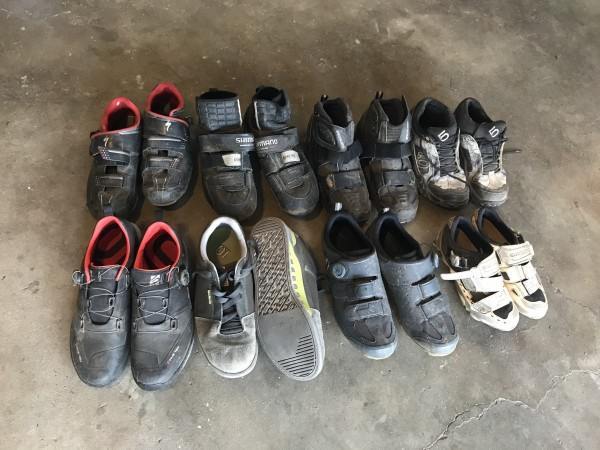
Q-Factor
Alright, are you ready for some minutia? We are about to get pretty techy, and the average biker may not need to know or care about Q-factor, so if you aren’t interested, skip ahead to meaty parts of this review.
For the sake of this review, we measured the distance between where the pedal meets the outside edge of the crank arm to the center of the clip-in mechanism with calipers on each pedal. What we found was that this distance varies by a few millimeters on several of the pedals, most notably on the Crankbrothers Mallet DH Race, which measured 58 mm. This is 5 mm wider than the similar Crankbrothers Mallet 3 and results in a 10 mm wider stance width when on the bike than if you were using the Mallet 3.
A wider Q-Factor allows for increased room for your foot to unclip without contacting the crank arm, especially when wearing bulky shoes like the Five Ten Hellcat. Sometimes soft and bulky shoes such as these, which are often worn when downhill riding, can hit the crank arm on a pedal with a narrower Q-factor, making unclipping more difficult.
Disadvantages to a wider Q-Factor are that you may find increased pedal strikes with the ground and obstacles such as rocks, and a decreased pedal efficiency. It is widely agreed upon that a narrower Q-factor is more efficient, even Sheldon Brown thought so.
How We Chose
This review evaluates eight different pairs of clipless mountain bike pedals. Keep reading to learn which ones we loved, which ones we didn’t care for, and which ones work best for certain types of bikes.
Ease of Entry
In general, entering the Shimano SPD pedals ends in a hard and satisfying click. You can feel it and hear it. By contrast, the Crankbrothers pedals feel much softer and smoother. Though there is still an audible click, it isn’t quite as hard or loud, and the sensation is more that of your cleat sliding gently into the pedal rather than the clicking into place feel you get with SPD pedals. Both styles of pedals are easy to get into, and this observation isn’t good or bad for either style, but just a noticeable difference between the two.
Overall, pedals with some type of platform are easier to get into. We scored the Shimano M530 and the Crankbrothers Mallet 3 and Mallet DH the highest. The platform guides the foot to the correct place, whereas the lack of platform, such as on the Eggbeater 2, requires precise aim to get engaged with the pedal.
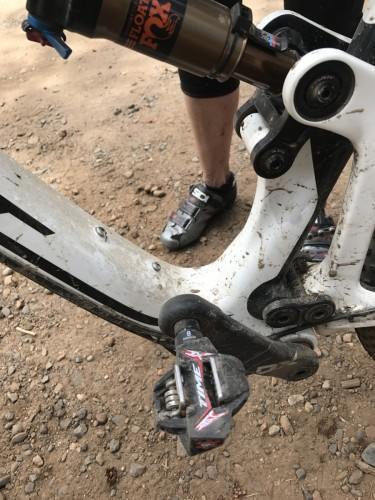
Ease of Exit
Ease of exit assesses how well and how quickly a rider can disengage from the pedals. This is important because this is what prevents you from falling over, and is how you separate yourself from your bike in a crash.
The easiest pedals to get out of are ones with no platform because there isn’t anything to get hung up on as your foot leaves the pedal. The ones that are the hardest to exit are the full platform pedals because the traction pins grip the sole of your shoe and provide additional friction.
Adjustability
We evaluated each pedal to see how many different types of adjustments could be made. Here one brand stands out over another. On all Shimano pedals you can adjust the tension of spring with a 3 mm allen. This allows you to customize how hard or soft the engagement is on the spring. If you are just starting out with clipless pedals, it can be looser and easier to get into, but this also makes it easier for your foot to come out, and it could unclip when you don’t want it to. Or it can be tighter and stiffer so it doesn’t disengage as easily, but it will be harder to get into. Keep in mind that when you adjust the tension it only adjusts one side at a time. You will want to also adjust the other side (since there is two-sided entry) and also both sides of the other foot so that the tension feels similar for every possible clip-in configuration. None of the Crankbrothers pedals have adjustable tension. They come with a preset tension and all feel fairly similar across the board.
Another way that some of the pedals are adjustable is traction pins. All of the full platform models in our test except the Shimano DX have removable traction pins. The Crankbrothers pins can also be dialed up for more grip and screwed in tighter for less grip on your shoes, depending on your taste. The HT X1 does have adjustable tension for the clip-n mechanism, but the traction pins cannot be lowered enough to make the friction very customizable, though they can be removed altogether.
Weight
While you may not mind another pound being added to your 40 lb downhill tank, cross-country riders tend to go to great lengths to keep their bikes lightweight. The lightest pedal in our review is the Crankbrothers Eggbeater 2 at 278 grams per pair. The heaviest is the Shimano DX at 574 per pair.
The most surprising result in the weight category is that the CB Mallet 3 (442 g per pair) actually weighs less than the Shimano M530 (450 g per pair), even though the Mallet 3 has more surface area. We found that overall the Shimano pedals weigh more than expected for the size.
Mud Shedding Ability
This is how likely it is for mud to clump onto the pedal and prevent the rider from clipping in. This is especially important for cyclocross racers who are hopping on and off bikes in muddy terrain all the time.
Just as with adjustability where one brand outshone another, here one brand takes the lead as well. All Crankbrothers pedals seem to shed mud a little easier than the Shimano SPD pedals. The spring mechanism is more open with the trademark Eggbeater design, and mud is less likely to clump in a way that prevents you from clipping into the pedal.
Platform
Here we analyze the platform size on the models in this review. Not every style of mountain biking needs a full platform pedal, however, there are some advantages to a wider surface area. The platform allows you to ride a short distance without being clipped in and gives you a little time to get your feet in the right place. It also helps you to find the pedal blindly. A platform also prevents the clipping mechanism from rolling underfoot as you try to engage with the pedal, making for faster and more comfortable entry. Lastly, a platform provides a little extra support with certain shoes and can be more comfortable if your shoes are softer.
No Platform
We tested two models with no platform at all, the Shimano M520 and the Eggbeater 2. Of the two, the Shimano pedal provides twice as much surface area even without a platform. We found the Eggbeater to require the most precise aim of any pedal because it is so tiny. Pedals with no platform are favored by cross-country riders and racers who value weight savings and don’t take their feet out very often.
Mini-Platform
We tested two mini-platform models, the Shimano M530, which is essentially the M520 with a small metal platform around it, and the Crankbrothers Candy 2, which is essentially the Eggbeater with a small metal platform around it. Of these two we prefer the larger platform of the M530, but both work well.
Throughout our review, we determined that the mini-platform pedals are the most versatile and widely appealing because they are easy to use, can go on almost any bike, and are very user-friendly. They are typically lighter weight than full platform pedals but are easier to clip into than pedals that lack a platform.
Full Platform
We tested four full platform pedals, the Ht X1, Shimano DX M647, Crankbrothers Mallet 3 and Mallet DH Race. All but one of these also come with traction pins on the platform to increase the grip between pedal and shoe. Our opinion is that Crankbrothers does full platform pedals better than anyone else so far. This style is the favorite of enduro racers and downhill riders who spend more time focused on the down than on the up.
Durability
Throughout our review, we rode hard, nailed rocks and trees with pedals, and we swapped them on different bikes with many different riders. Overall, very few durability issues came to light. We did notice that the bearings in one of our Mallet DH pedals began to grind. It didn’t fail, but it feels slightly crunchy when the pedal turns.
We have noticed that eventually, Crankbothers pedals need to have the bearings replaced (they sell a kit for this) but we have never had to touch a Shimano pedal, even after years of use. In fact, the Shimano M530 and M520 seem impossible to kill. After many seasons of use and lots of dings and scratches, they just keep on working.
How We Tested
We tested these eight pairs of clipless mountain bike pedals in conjunction with eleven mountain bikes and eight pairs of mountain bike shoes, and we had a whole team of bikers use them. We set up multiple pairs of shoes with different style cleats and swapped pedals out for different riders on different bikes throughout the summer. This gave us a unique perspective on pedals.
We were able to go above and beyond by having men and women riders with different riding styles and preferences as well was different ability levels try each pair. The pedals made it onto enduro bikes, cross-country bikes, and downhill bikes. They were used with downhill oriented shoes like like the Five Ten Hellcat, cross-country style shoes like the Sidi Dominator 5 Fit, and even pairs of bike shoes that we got for $20 at the thrift store.
We weighed each pedal and each set of cleats and compared these weights with claimed manufacturer weights. We measured the dimensions of each platform ourselves with calipers, and we based this measurement off of what we thought was a reasonable surface to stand on (which did not include the tapered edges or sloped sides of the pedals). We also measured the Q-factor of each pedal with calipers, and this is the distance between where the edge of the pedal would meet the crank arm and the center of the clip-in mechanism. We clipped in and out of each pair, nailed rocks, and rode hard.
After spending a summer swapping pedals on different bikes, let’s just say we got really good with a pedal wrench and used up almost an entire tube of grease. Hopefully, our information is helpful to you when making a purchasing decision about what pedals to run on your precious new bike.
Conclusion
There are many things to consider when buying a pair of bike pedals. Depending on the style of bike you have, and whether you are wanting clipless or flat pedals, the best pair may vary to meet your individual needs. Using our tests and ratings, this review is intended to help you make that decision with ease.

